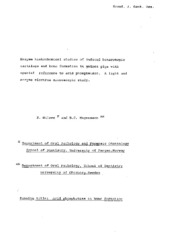Enzyme histochemical studies of induced heterotopic cartilage and bone formation in guinea pigs with special references to acid phosphatise. A light and enzyme electron microscopic study
Journal article
Submitted version
Permanent lenke
https://hdl.handle.net/1956/2187Utgivelsesdato
1981Metadata
Vis full innførselSamlinger
Sammendrag
Heterotopic bone and cartilage formation was studied in a bone induction model in abdominal muscles of guinea pigs using demineralized allogenic dentin as inductive material. The light microscopical study showed high activity of acid phosphatise (AcP) and leucine aminopeptidase (LAP) in young matrix-producing cells. The highest activity was seen in cells surrounded by inmineralized matrix. In the surrounding matrix there was strong staining of AcP, especially in matrix with high glycosaminoglycan content. Electron microscopical studies of AcP in unfixed frozen tissue showed intra-cellular activity mainly located in lysosomes. Extracellular AcP was found in matrix vescicles in the newly formed hard tissue. It was most pronounced in areas of cartilaginous differentiation. By means of energy dispersive x-ray microanalysis in a scanning transmission electron microscope, the deposits were confirmed to contain lead precipitates. With the exception of some lysosomal staining, prefixation with formaldehyde prevented demonstration of the enzyme activity. Both AcP and LAP may be involved in degradation of glycosaminoglycans or other organic components of the matrix which enable the matrix to mineralize.
Beskrivelse
Published as: Enzyme histochemical studies of induced heterotopic cartilage and bone formation in guinea pigs with special references to acid phosphatise
